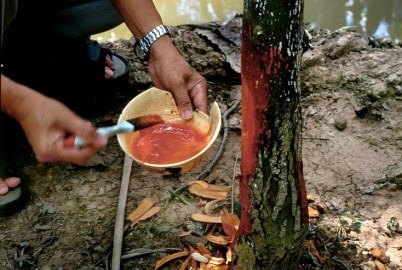Page 1 of 5Plant disease control is pre-occupied with pathogens that infect foliage and fruit although those attacking the bark and wood are altogether more economically damaging, especially in the longer term
With the right treatment, trees will usually recover quickly from foliar infection and live to crop in the following season or year, but not so for trees suffering from untreated stem canker diseases.
These diseases can kill mature fruit bearing trees by girdling the trunk and wipe out years of investment and future yield. Phytophthora, a fungal-like pathogen belonging to the Oomycetes and now regarded as closer to the algae than the true fungi, is by far the most important canker-causing pathogen in the tropics.
Canker control
Three key steps in Phytophthora canker control are: cleaning the canker; treatment of the cleaned area with cuprous oxide fungicide paint; and sealing with waterproof and insect proof layers of grease.
Failure to perform each stage using the most appropriate tools and materials jeopardises success of the entire operation.
Canker-cleaning requires a range of sharp clean tools including machetes (cutlasses), knives, scrapers and chisels (with hammer) to facilitate fast and efficient removal of all infected bark, as well as healthy bark several centimetres beyond the edge of the canker, and sufficiently deep to expose clean disease-free wood. Excised bark material is bagged and removed for incineration. All canker cleaning tools are routinely disinfected before moving on to the next canker whether it is on the same or a different tree.
Canker paint is prepared by mixing cuprous oxide as wettable powder, granule or flowable formulation in water to produce an aqueous mixture with a paint-like viscosity. Viscosity is accelerated and enhanced adding an appropriate adjuvant sticker. Required strength (concentration of cuprous oxide) and viscosity is most easily and rapidly achieved by using high-copper formulations such as Nordox 75 per cent WG (wettable granule).
Traditionally-used canker paints are aqueous (water-based) but farmers in some South East Asian countries have found oil-emulsion paints, obtained by adding locally available vegetable oils, actually increase penetration of active copper fungicide into the bark and wood for extra protection and control. Nordox has an oil-based flowable formulation of cuprous oxide fungicide called ‘Nordox Oleo Ultra’ that can be used in this way to produce oil emulsion canker paint. Best results are obtained by brushing liberal amounts of paint over the entire area of the excised bark and at least 5 cm beyond over healthy intact bark.
There are no hard and fast rules governing concentration of cuprous oxide (active copper) used in the paint. There is unlikely to be any adverse reaction from the bark or wood since cuprous oxide has been safely used for almost 90 years on almost every commercial tree crop in the world. Since the paint must remain at biocidal concentrations until the area is healed and sealed, which may be months or even more than a year depending on size, type of tree and climate, it is best to use a high concentration of copper in the paint.




